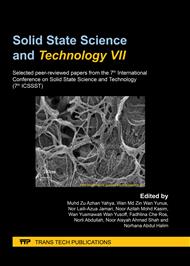p.341
p.351
p.361
p.369
p.377
p.385
p.393
p.400
p.406
Investigation on the Dielectric Properties of Palm Oil with Silicon Carbide Doping for Transformer Application
Abstract:
The dielectric strength of insulating liquids of transformer acts an important parameter in the operation of transformer. Thus, great interest and many studies have been extensively done to improve the dielectric strength. One of study is the introduction of nanoparticle in the transformer oils. Study of the nanoparticles for the last few years had been found that, it can be dispersed in the transformers oils to be nanofluids and directly enhance the transformer performance. In this study, an investigation has been carried out to focus on the effect of silicon carbide (SiC) nanoparticle to AC (alternating current) breakdown voltage of the Refined, Bleached, and Deodorized Palm Oil (RBDPO). AC breakdown test have been conduct according to the standard of the IEC 60156. Besides that, a number of parameters will be evaluated such as dielectric dissipation factor (tan δ), relative permittivity (ε), and resistivity (ρ). Based on the results of the experiment, the electrode gap at 2.5 mm having the highest AC breakdown voltage compared to the other electrode gap which are 1.0 mm, 1.5 mm and 2.0 mm. Furthermore, doping with different concentrations of the silicon carbide (SiC) in Refined, Bleached, and Deodorized Palm Oil (RBDPO) found decreasing of AC breakdown voltage from 52.09 kV (without SiC) to 45.3 kV for 0.001 g/L, 43.2 kV for 0.003 g/L and 40.1 kV for 0.005 g/L respectively.
Info:
Periodical:
Pages:
377-382
Citation:
Online since:
May 2021
Keywords:
Price:
Сopyright:
© 2021 Trans Tech Publications Ltd. All Rights Reserved
Share:
Citation:


